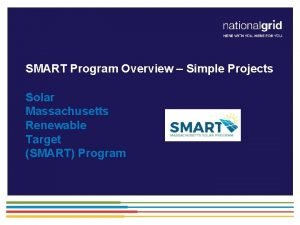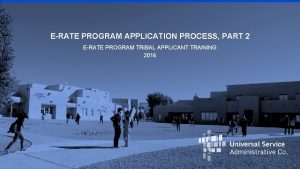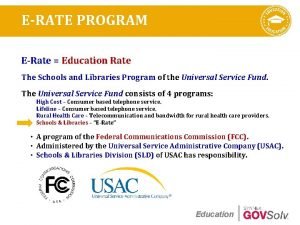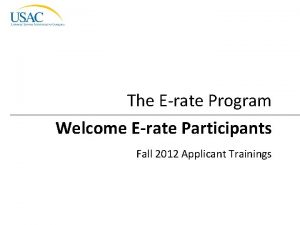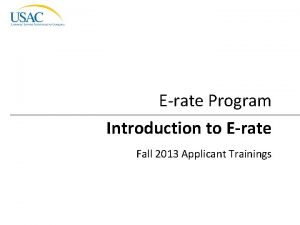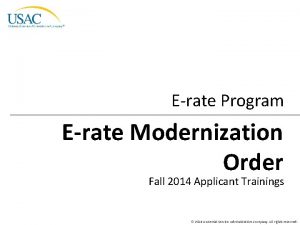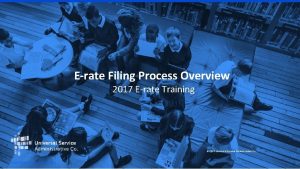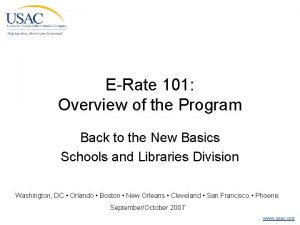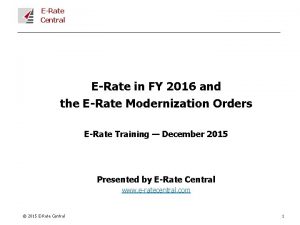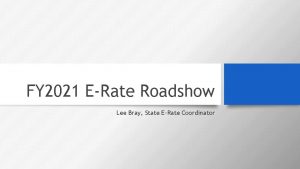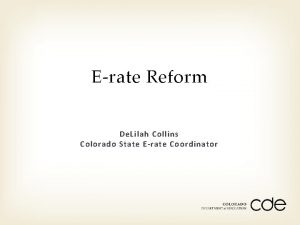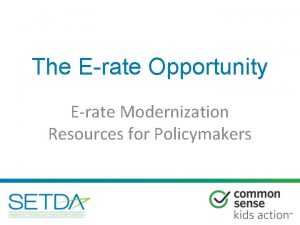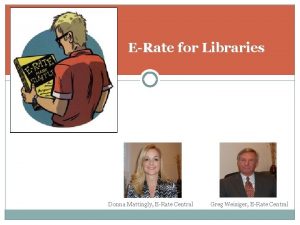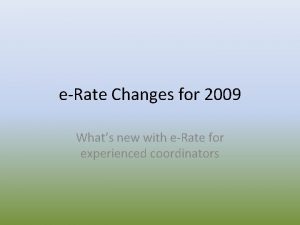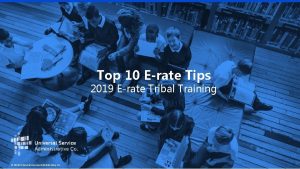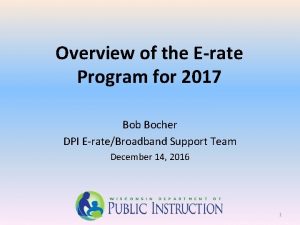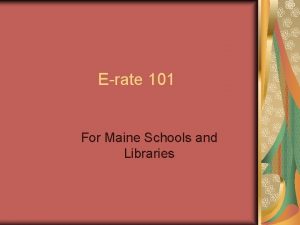ERATE 101 OVERVIEW OF THE ERATE PROGRAM ERATE
































- Slides: 32

E-RATE 101 OVERVIEW OF THE E‐RATE PROGRAM

E-RATE 101 BEFORE WE BEGIN: What IS E‐rate? One of four Universal Service Fund programs that allow for eligible schools and libraries to apply for discounts on their Internet, Data Transmission, and internal connections services. 2

E-RATE 101 When it began Who is eligible? • Congress directed the FCC • K‐ 12 schools and school to establish the E‐rate districts. Program in 1996. • Non‐traditional educational entities • Telecommunications Act (differs by state). of 1996 • Libraries and Library • Program Began January systems. 1998. • School and Library Consortia. 3

E-RATE 101 ELIGIBILITY REQUIREMENTS Schools must meet the statutory definition of elementary and secondary schools found in the No Child Left Behind Act of 2001 (20 U. S. C. Section 7801(18) and (38)) • An elementary school is a non‐profit institutional day or residential school, including a public elementary charter school, that provides elementary education, as determined under state law. • A secondary school is a non‐profit institutional day or residential school, including a public secondary charter school, that provides secondary education, as determined under state law, except that such term does not include any education beyond grade 12 Ø Schools operating as for‐profit businesses or that have endowments exceeding $50 million are not eligible

E-RATE 101 Head Start and Pre‐K students ages 3‐ 5 are eligible in Florida 5

E-RATE 101 ELIGIBILITY REQUIREMENTS The definition of a library includes: • A public library / An academic library • A public elementary school or secondary school library • A research library, one that makes publicly available library services and material suitable for scholarly research and not otherwise available to the public and is not an integral part of an institution of higher education • A private library, but only if the state in which such private library is located determines that the library should be considered a library for purposes of this definition

E-RATE 101 ELIGIBILITY REQUIREMENTS Libraries must meet the statutory definition of library or library consortium found in the Library Services and Technology Act of 1996 (LSTA) (20 U. S. C. Section 9122) and must be eligible for assistance from a state library administrative agency under that Act. A library's eligibility for support also depends on its funding as an independent entity. Only libraries whose budgets are completely separate from any schools, including but not limited to, elementary and secondary schools, colleges and universities shall be eligible to receive discounted services

E-RATE 101 FCC- Federal Communications Commission an independent U. S. government agency, established and oversees the E‐rate program. USAC- Universal Service Administrative Company, a not‐for‐profit, administers the E‐rate program along with three other programs. SLD- Schools and Libraries Division is the part of USAC with responsibility for E‐rate. Billed Entity- The entity that receives the bill and pays for the supported service. Applicant- The entity applying for universal service support (i. e. , a school, library, consortium, or other eligible entity that files program forms. ) 8

E-RATE 101 FCC Form 470 - competitive bidding form for services desired that are eligible for discounts under the E‐rate Program. FCC Form 471 - the application process used for requesting services listed on Form 470. FCC Form 486 - The Receipt of Service Confirmation Form. Filed letting you know when service will begin and will comply with CIPA requirements. Funding Commitment Decision Letter (FCDL)- Notification letter sent to applicant after PIA review is complete and the application has been “approved”. 9

E-RATE 101 BEAR- Applicant filed form submitted to USAC for reimbursement (Applicant pays full cost of service and files BEAR for discounted share. ) SPI- Service Provider Invoicing method. Applicant pays only their non‐discounted share and receives discount for the remainder of the cost of service. Related Entities (Entity Profiles)- Section in the 471 application to determine discount; a complete list of schools in district. BEN “Billed Entity Number”- the unique number assigned by USAC to each billed entity that pays for services and/or recipient of 10 service.

E-RATE 101 Non-Instructional Facility (NIF)- A school building without classrooms or a library building without public areas. Eligible only for Category One services; does not receive Category Two budget. Funding Request Number (FRN)- Unique number that USAC assigns to each funding request in a completed FCC Form 471. (Three types: Internet Access, Telecommunications, Voice) FRN Key Information: FRN Section of 471 application where the applicant provides details of services requested including service provider, contract information, and category of service. FRN Line-item- Provides detail of services requested, including type, purpose, amount/quantity, and, recipient of service monthly 11 cost of service.

E-RATE 101 DISCOUNTS E‐rate applicants apply for discounts on their Internet Access and Telecommunication services. Applicants pay only the non‐discounted portion. Example: School District with a 70% discount applies for a 1, 000 mbps Internet Access at $30, 000 total eligible annual cost. 70% x $30, 000 = $21, 000 Customer would be “reimbursed” in the amount of $21, 000 after filing their BEAR. 12

E-RATE 101 Discounts are based on the percentage of students eligible for the National School Lunch Program (NSLP) and total student count. Range from 20‐ 90 or 20‐ 85 percent of eligible costs, depending on category of service. Discount level for a school or library depends on: • Level of economic need • Urban or rural designation • If 51% of entities are rural, the district or library system is rural. If it’s 50/50, you are urban. • An individual school or library is designated as "urban" if located in an "Urbanized Area" or "Urban Cluster" with a population of 25, 000 or more as determined by the U. S. Census Bureau 13

E-RATE 101 Discount Calculation Example: School District (10 schools) ―Total student population of all schools = 3, 000 students ―Total students eligible for NSLP = 1, 000 students ― 1, 000 students eligible for NSLP/ 3, 000 students = 33% eligible. ― 70% of district is rural; district receives rural discount rate. 14

E-RATE 101 70% Rural 15

E-RATE 101 Libraries and Library System • Libraries get their discount based on the percentage of students eligible for the NSLP in the school district in which the main outlet is located. • No longer calculate discount based on all districts in which library system has outlets. • Libraries calculate their own urban/rural status based on their own outlets. Therefore, the library system’s discount may not match the school district’s discount rate. • Bookmobile and kiosks count as library outlets. 16

E-RATE 101 Discount Calculation Example: Library System ― 9 outlets + 1 kiosk ―Located in a district with a 68% NSLP percentage ― 5 outlets are rural, 5 are urban. URBAN 17

E-RATE 101 Urban 18

E-RATE 101 Consortia calculate their discount based on the simple average of their consortia members. • All consortia members now are listed at their district‐wide discount rate, even if only some schools in the district participate in the consortium. • Only consortia entities can get a discount that doesn’t come straight from the discount matrix. All funding request numbers (FRN), regardless of the entities served, get the same consortia‐wide discount rate. 19

E-RATE 101 Discount Mechanisms: 1. National School Lunch Program (NSLP). 2. Community Eligibility Program (CEP). 3. Survey. 20

E-RATE 101 Discount Mechanisms 1. National School Lunch Program (NSLP) The national school lunch program determines students' eligibility for free or reduced‐price lunches based on family income, A school may use either: • An actual count of students eligible for the national school lunch program or; • Federally-approved alternative mechanisms to determine the level of poverty for purposes of the universal service discount program. 21

E-RATE 101 Discount Mechanisms 2. Community Eligibility Provision (CEP) • Schools utilizing the CEP shall calculate their student eligibility for free or reduced priced lunches by multiplying the percentage of directly certified students by the CEP national multiplier. To compensate for low income families not reflected in the direct certification data, schools apply a standard, national multiplier, currently set at 1. 6. If, during the four-year cycle, a school’s percentage of identified students increases, the school may use the higher percentage in determining USDA reimbursement. If the percentage of identified students decreases, the school may continue to use the original percentage for the remainder of the four‐year eligibility period. 22

E-RATE 101 Alternative Discount Mechanisms 3. Surveys Must be sent to all families whose children attend the school. The survey must, at a minimum, contain the following information: • Name of family and students; • Size of the family; and • Income level of the family. Income data cannot be older than two years before the start of the funding year (FY). The results of a survey may not be extrapolated and must be based on the actual student numbers. 23

E-RATE 101 Categories of Service Category One: Services needed to support broadband connectivity to schools and libraries *Outside the demarcation point – Telecom – Internet Access Category Two: Those needed for broadband connectivity within geographically contiguous schools and libraries *Inside the demarcation point – Internal Connections – Management of Internal Broadband services – Management of Internal Connections 24

E-RATE 101 CATEGORY TWO BUDGETS Each individual school and each library outlet or branch has a Category Two “budget”. • $150 per student (school) or $1. 30 per square foot (library). • 5$ per square foot for large urban populations of 250, 000+ (library). • 1 billion per year pilot budget from 2015‐ 2019 No budget for Non‐instructional facilities (NIFs) – including school NIFs with classrooms and administrative buildings. Districts or library systems may not average costs or share budgets across multiple schools or libraries. 25

E-RATE 101 What is the Applicant Process? Competitive Bidding Apply for Discounts Start Services Invoice USAC © 2019 Universal Service Administrative Co.

E-RATE 101 THE E-RATE YEAR Jun FCC Form 470 (Competitive bidding) Jul May Aug Apr Sep July 2020 – June 2021 Mar Oct Feb Nov Jan Dec 27

E-RATE 101 THE E-RATE YEAR Jun FCC Form 470 (Competitive bidding) Jul May Aug Apr Sep July 2020 – June 2021 Mar Oct Feb Nov Jan Dec FCC Form 471 (Application) 28

E-RATE 101 FCC Form 470 (Competitive bidding) PIA Review Jun Jul May Aug Apr Sep July 2020 – June 2021 Mar Oct Feb Nov Jan Dec FCC Form 471 (Application) 29

E-RATE 101 FCC Form 470 (Competitive bidding) PIA Review Jun Jul May Aug Apr Sep July 2020 – June 2021 Mar Oct Feb Nov Jan FCC Form 471 (Application) Dec Invoicing 30

E-RATE 101 FCC Form 470 (Competitive bidding) PIA Review Jun Category Two installation can begin. Jul May Aug Apr Sep July 2020 – June 2021 Mar Oct Feb Nov Jan Dec FCC Form 471 (Application) Invoicing Fiber special construction can begin. 31

E-RATE 101 Invoicing Methods Form 472 (BEAR): Billed Entity Applicant Reimbursement Filed by applicant for discounted portion after services have been paid in full. Applicants must file form 498 for direct payment. Form 474 (SPI): Service Provider Invoice Filed by service provider after the applicant has been billed for the non‐discounted portion of eligible services 32
 Sbic program overview
Sbic program overview Overview on the national tuberculosis elimination program
Overview on the national tuberculosis elimination program Ma smart program overview
Ma smart program overview Hình ảnh bộ gõ cơ thể búng tay
Hình ảnh bộ gõ cơ thể búng tay Lp html
Lp html Bổ thể
Bổ thể Tỉ lệ cơ thể trẻ em
Tỉ lệ cơ thể trẻ em Gấu đi như thế nào
Gấu đi như thế nào Chụp phim tư thế worms-breton
Chụp phim tư thế worms-breton Chúa yêu trần thế alleluia
Chúa yêu trần thế alleluia Các môn thể thao bắt đầu bằng tiếng nhảy
Các môn thể thao bắt đầu bằng tiếng nhảy Thế nào là hệ số cao nhất
Thế nào là hệ số cao nhất Các châu lục và đại dương trên thế giới
Các châu lục và đại dương trên thế giới Công của trọng lực
Công của trọng lực Trời xanh đây là của chúng ta thể thơ
Trời xanh đây là của chúng ta thể thơ Cách giải mật thư tọa độ
Cách giải mật thư tọa độ Làm thế nào để 102-1=99
Làm thế nào để 102-1=99 độ dài liên kết
độ dài liên kết Các châu lục và đại dương trên thế giới
Các châu lục và đại dương trên thế giới Thể thơ truyền thống
Thể thơ truyền thống Quá trình desamine hóa có thể tạo ra
Quá trình desamine hóa có thể tạo ra Một số thể thơ truyền thống
Một số thể thơ truyền thống Bàn tay mà dây bẩn
Bàn tay mà dây bẩn Vẽ hình chiếu vuông góc của vật thể sau
Vẽ hình chiếu vuông góc của vật thể sau Biện pháp chống mỏi cơ
Biện pháp chống mỏi cơ đặc điểm cơ thể của người tối cổ
đặc điểm cơ thể của người tối cổ Thứ tự các dấu thăng giáng ở hóa biểu
Thứ tự các dấu thăng giáng ở hóa biểu Vẽ hình chiếu đứng bằng cạnh của vật thể
Vẽ hình chiếu đứng bằng cạnh của vật thể Fecboak
Fecboak Thẻ vin
Thẻ vin đại từ thay thế
đại từ thay thế điện thế nghỉ
điện thế nghỉ Tư thế ngồi viết
Tư thế ngồi viết


